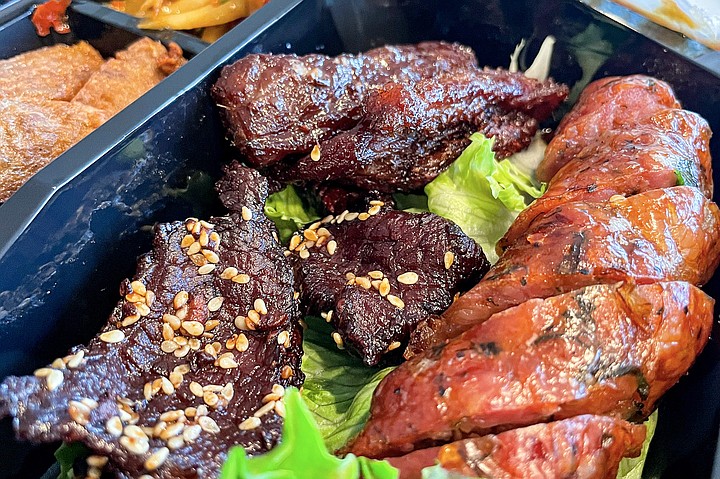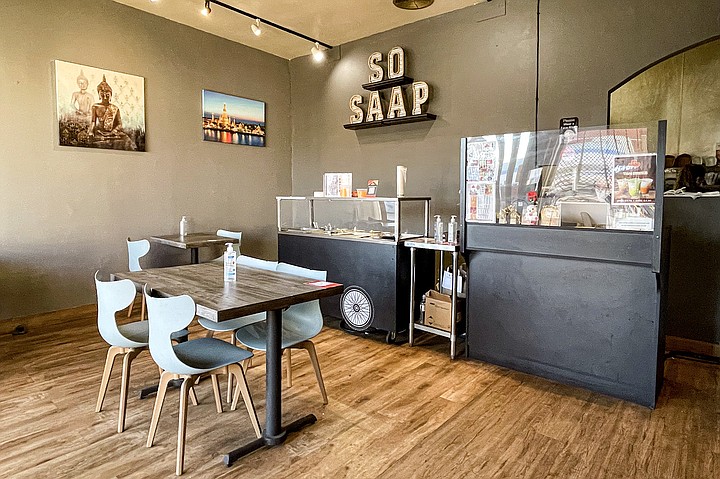 Facebook
Facebook
 X
X
 Instagram
Instagram
 TikTok
TikTok
 Youtube
Youtube

Whichever cuisine they serve, planned restaurants that went ahead and opened after the pandemic started deserve a special kind of acclaim. The business is notoriously tough under normal circumstances — well publicized studies contend as many as 60 percent of restaurants fail within their first year. So imagine how much tougher it was for new businesses trying to drum up the critical mass of regular customers needed to stay afloat, while hamstrung by indoor dining restrictions and a covid concerned clientele.
Now imagine trying to do so while featuring a lesser-known cultural cuisine. Those are the overlapping challenges So Saap faced when it opened last June, with a menu mainly of Lao food.
So Saap operates within a tiny, aging shopping strip at 47th and Market in an ill-defined part of southeast San Diego called Chollas View. It’s too far south to be City Heights, and on the wrong wide of 805 to be considered Mt. Hope. Although several small restaurants do business around that intersection, it’s not a part of town that has historically been considered a robust dining destination.
And yet, they tell me they’ve done pretty well, all things considered. People found them. And there’s really only one reason that stands out as to why: So Saap makes fantastic food.
I don’t have a ton of experience with Lao food — only so many of us do in this city. Though dishes from Laos often appear on Thai restaurant menus (many dishes are cross-cultural between the neighboring nations) they rarely count among the most popular. Since So Saap serves such dishes as pad see ew, panang curry, papaya salad, and tom kha soup, it would be easy for customers to mistake it for a Thai restaurant.

Actually, you could easily regard it as mainly a Thai restaurant and never look back. It might even become one of your favorites. But you’d be doing yourself a disservice. Because So Saap was good enough to start me on a lifetime of Lao cravings.
What I do know about Lao cuisine mostly involves larb, so there was little question I would have to try the ground meat and toasted rice salad. I’ve learned just enough to know my palate can’t handle the so-called bitter larb usually preferred by Lao folk — made that way by beef bile and tripe. So I avoided the beef larb ($11) altogether. So Saap offers a vegan, tofu larb ($10) I knew would be friendlier, but I was right to choose the chicken larb ($10).

This was meant to be a posterity order, something I took a few bites of during dinner, then stashed in the fridge to become tomorrow’s lunch. But it packed so much flavor into each bite — lime, fish sauce, chilis, and herbs — that I kept coming back to it, and back to it again. There’s would be no leftovers.
But larb isn’t even the first thing I recommend ordering at So Saap. If you try nothing else here, start with the Laos Famous Plate ($13). Think of it as a sampler platter of Lao meats, beginning with beef jerky.

I’m not normally one to espouse ordering beef jerky at a restaurant, but in this case we’re talking about the best beef jerky I’ve ever eaten. The famous plate features two types of jerky, and the first, called seen lod is darn tasty in its own right: it’s soft, with distinguishing flavors of ginger and lemongrass.
But the best thing I’ve eaten so far in 2021 has to be the seen savanh, which apparently translates to ‘heavenly jerky.’ Also soft, this one’s a little darker and a little sweeter, and ultimately less complex. But a sprinkling of sesame seeds on each bite-size morsel add just enough to the balance of sweetness and pepper that the use of ‘heavenly’ to describe it no longer seems far-fetched.
Heavenly jerky is the star of the famous plate, and available on its own as an $8 side dish. But I’d still recommend getting the whole famous plate, because it includes papaya salad, a plastic bag of sticky rice, and Lao sausage, a spicy, lemongrassy piece of grilled pork sausage that hits every mark. Also, don’t sleep on the small serving of jeow mak len, or what the menu calls “jel tomato sauce.” It’s simple enough, but the spicy, salsa-like tomato sauce offers its own world of flavor, so now I’m looking for jars of the stuff.
So Saap has just, finally started serving on premise, though its street food takeout game is strong, and well worth a try for those not dining in yet. That the little shop has made it this far should be testament to its quality, and if you’re uncertain, check the shop’s Instagram for a parade of daily specials ranging from garlic fried ribs to fried fish. Despite the presence of, let’s say, advanced menu items including boat noodle soup with liver, tripe, and beef blood, I really think this could be the place that makes Lao food a San Diego favorite.


Whichever cuisine they serve, planned restaurants that went ahead and opened after the pandemic started deserve a special kind of acclaim. The business is notoriously tough under normal circumstances — well publicized studies contend as many as 60 percent of restaurants fail within their first year. So imagine how much tougher it was for new businesses trying to drum up the critical mass of regular customers needed to stay afloat, while hamstrung by indoor dining restrictions and a covid concerned clientele.
Now imagine trying to do so while featuring a lesser-known cultural cuisine. Those are the overlapping challenges So Saap faced when it opened last June, with a menu mainly of Lao food.
So Saap operates within a tiny, aging shopping strip at 47th and Market in an ill-defined part of southeast San Diego called Chollas View. It’s too far south to be City Heights, and on the wrong wide of 805 to be considered Mt. Hope. Although several small restaurants do business around that intersection, it’s not a part of town that has historically been considered a robust dining destination.
And yet, they tell me they’ve done pretty well, all things considered. People found them. And there’s really only one reason that stands out as to why: So Saap makes fantastic food.
I don’t have a ton of experience with Lao food — only so many of us do in this city. Though dishes from Laos often appear on Thai restaurant menus (many dishes are cross-cultural between the neighboring nations) they rarely count among the most popular. Since So Saap serves such dishes as pad see ew, panang curry, papaya salad, and tom kha soup, it would be easy for customers to mistake it for a Thai restaurant.

Actually, you could easily regard it as mainly a Thai restaurant and never look back. It might even become one of your favorites. But you’d be doing yourself a disservice. Because So Saap was good enough to start me on a lifetime of Lao cravings.
What I do know about Lao cuisine mostly involves larb, so there was little question I would have to try the ground meat and toasted rice salad. I’ve learned just enough to know my palate can’t handle the so-called bitter larb usually preferred by Lao folk — made that way by beef bile and tripe. So I avoided the beef larb ($11) altogether. So Saap offers a vegan, tofu larb ($10) I knew would be friendlier, but I was right to choose the chicken larb ($10).

This was meant to be a posterity order, something I took a few bites of during dinner, then stashed in the fridge to become tomorrow’s lunch. But it packed so much flavor into each bite — lime, fish sauce, chilis, and herbs — that I kept coming back to it, and back to it again. There’s would be no leftovers.
But larb isn’t even the first thing I recommend ordering at So Saap. If you try nothing else here, start with the Laos Famous Plate ($13). Think of it as a sampler platter of Lao meats, beginning with beef jerky.

I’m not normally one to espouse ordering beef jerky at a restaurant, but in this case we’re talking about the best beef jerky I’ve ever eaten. The famous plate features two types of jerky, and the first, called seen lod is darn tasty in its own right: it’s soft, with distinguishing flavors of ginger and lemongrass.
But the best thing I’ve eaten so far in 2021 has to be the seen savanh, which apparently translates to ‘heavenly jerky.’ Also soft, this one’s a little darker and a little sweeter, and ultimately less complex. But a sprinkling of sesame seeds on each bite-size morsel add just enough to the balance of sweetness and pepper that the use of ‘heavenly’ to describe it no longer seems far-fetched.
Heavenly jerky is the star of the famous plate, and available on its own as an $8 side dish. But I’d still recommend getting the whole famous plate, because it includes papaya salad, a plastic bag of sticky rice, and Lao sausage, a spicy, lemongrassy piece of grilled pork sausage that hits every mark. Also, don’t sleep on the small serving of jeow mak len, or what the menu calls “jel tomato sauce.” It’s simple enough, but the spicy, salsa-like tomato sauce offers its own world of flavor, so now I’m looking for jars of the stuff.
So Saap has just, finally started serving on premise, though its street food takeout game is strong, and well worth a try for those not dining in yet. That the little shop has made it this far should be testament to its quality, and if you’re uncertain, check the shop’s Instagram for a parade of daily specials ranging from garlic fried ribs to fried fish. Despite the presence of, let’s say, advanced menu items including boat noodle soup with liver, tripe, and beef blood, I really think this could be the place that makes Lao food a San Diego favorite.
Comments